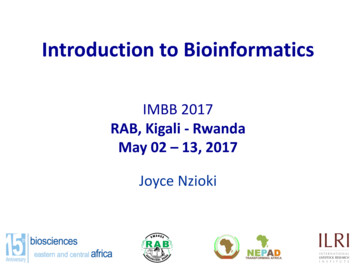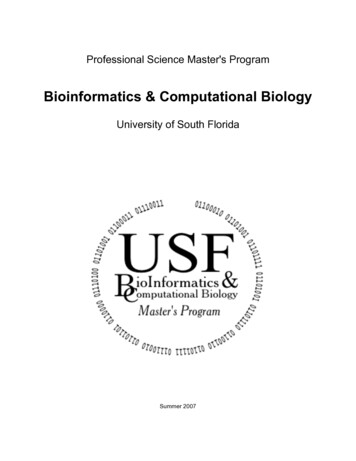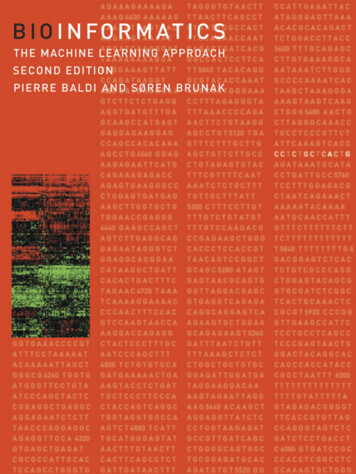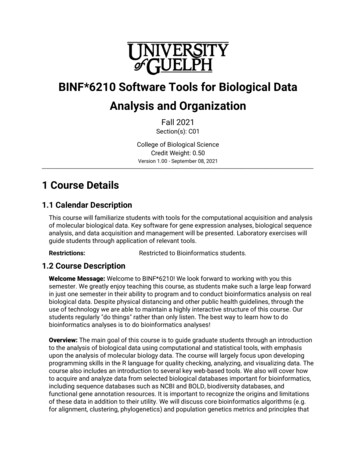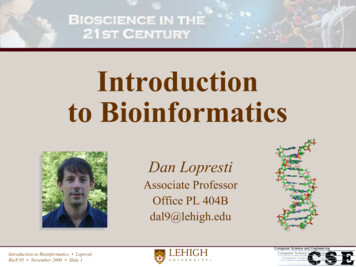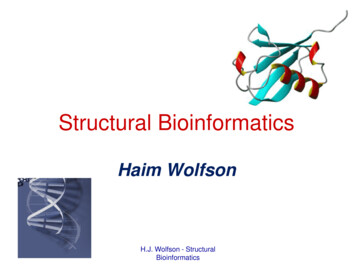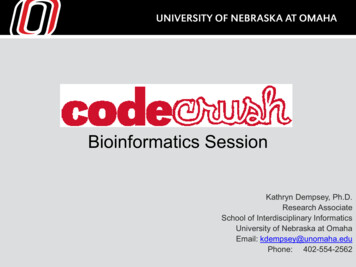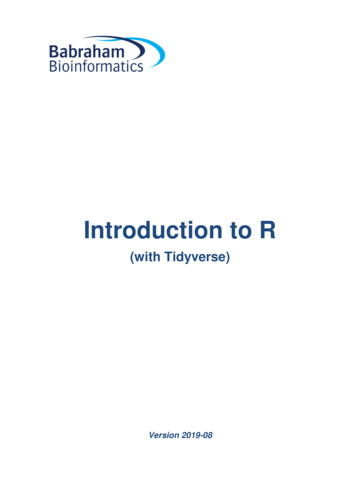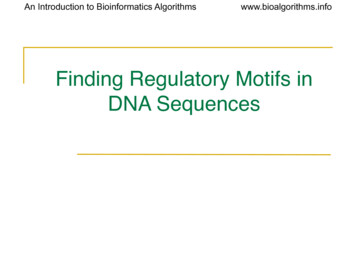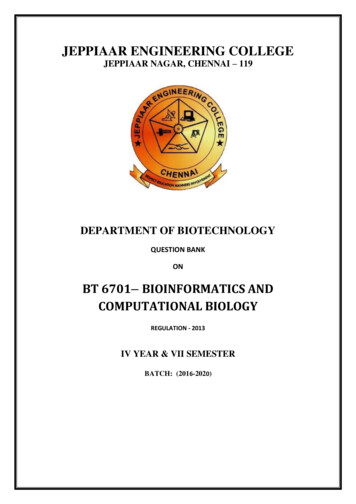
Transcription
JEPPIAAR ENGINEERING COLLEGEJEPPIAAR NAGAR, CHENNAI – 119DEPARTMENT OF BIOTECHNOLOGYQUESTION BANKONBT 6701– BIOINFORMATICS ANDCOMPUTATIONAL BIOLOGYREGULATION - 2013IV YEAR & VII SEMESTERBATCH: (2016-2020)
VISION OF THE INSTITUTION To build Jeppiaar Engineering College as an institution of academic excellence intechnological and management education to become a world class UniversityMISSION OF THE INSTITUTION To excel in teaching and learning, research and innovation by promoting the principles ofscientific analysis and creative thinking.To participate in the production, development and dissemination of knowledge and interactwith national and international communities.To equip students with values, ethics and life skills needed to enrich their lives and enable themto meaningfully contribute to the progress of society.To prepare students for higher studies and lifelong learning, enrich them with the practicaland entrepreneurial skills necessary to excel as future professionals and contribute to Nation’seconomyPROGRAM OUTCOMES (PO)PO 1PO 2PO 3PO 4PO 5PO 6PO 7PO 8PO 9PO 10PO 11PO 12Engineering knowledge: Apply the knowledge of mathematics, science, engineeringfundamentals, and an engineering specialization to the solution of complex engineering problems.Problem analysis: Identify, formulate, review research literature, and analyze complexengineering problems reaching substantiated conclusions using first principles of mathematics,natural sciences, and engineering sciences.Design/development of solutions: Design solutions for complex engineering problems anddesign system components or processes that meet the specified needs with appropriateconsideration for the public health and safety, and the cultural, societal, and environmentalconsiderationsConduct investigations of complex problems: Use research-based knowledge and researchmethods including design of experiments, analysis and interpretation of data, and synthesis ofthe information to provide valid conclusions.Modern tool usage: Create, select, and apply appropriate techniques, resources, and modernengineering and IT tools including prediction and modeling to complex engineering activities with anunderstanding of the limitations.The engineer and society: Apply reasoning informed by the contextual knowledge to assesssocietal, health, safety, legal and cultural issues and the consequent responsibilities relevant to theprofessional engineering practice.Environment and sustainability: Understand the impact of the professional engineering solutionsin societal and environmental contexts, and demonstrate the knowledge of, and need forsustainable development.Ethics: Apply ethical principles and commit to professional ethics and responsibilities and norms ofthe engineering practice.Individual and team work: Function effectively as an individual, and as a member or leader indiverse teams, and in multidisciplinary settings.Communication: Communicate effectively on complex engineering activities with theengineering community and with society at large, such as, being able to comprehend and writeeffective reports and design documentation, make effective presentations, and give and receiveclear instructions.Project management and finance: Demonstrate knowledge and understanding of theengineering and management principles and apply these to one’s own work, as a member andleader in a team, to manage projects and in multidisciplinary environments.Life-long learning: Recognize the need for, and have the preparation and ability to engage inindependent and life-long learning in the broadest context of technological change.
VISION OF THE DEPARTMENTTo pursue excellence in producing bioengineers coupled with research attributes.MISSION OF THE DEPARTMENTM1To impart quality education and transform technical knowledge into career opportunities.M2To establish a bridge between the program and society by fostering technical education.M3To generate societal conscious technocrats towards community developmentM4To facilitate higher studies and research in order to have an effective career / entrepreneurship.PROGRAM EDUCATIONAL OBJECTIVES (PEOS)PEO - 1PEO - 2To impart knowledge and produce competent graduates in the field of biotechnologyTo inculcate professional attributes and ability to integrate engineering issues to broader socialcontexts.PEO - 3To connect the program and community by fostering technical education.PEO - 4To provide a wide technical exposure to work in an interdisciplinary environmentPEO - 5To prepare the students to have a professional career and motivation towards higher education.PROGRAM SPECIFIC OUTCOMES (PSOS)PSO 1PSO 2PSO 3Professional Skills: This programme will provide students with a solid foundation in the field ofBiological Sciences and Chemical engineering enabling them to work on engineering platforms andapplications in Biotechnology as per the requirement of Industries, and facilitating the students topursue higher studiesProblem-solving skills: This programme will assist the students to acquire fundamental and problemsolving knowledge on subjects relevant to Biotechnology thereby encouraging them to understandemerging and advanced concepts in modern biologySuccessful Career and Entrepreneurship: Graduates of the program will have a strong successfulcareer and entrepreneurial ability with the blend of inputs from basic science, engineering andtechnology, thereby enabling them to translate the technology and tools in various industries and/orinstitutes
BT6701 BIOINFORMATICS AND COMPUTATIONAL BIOLOGY LT P C3003OBJECTIVES: To improve the programming skills of the student To let the students know the recent evolution in biological science.UNIT I9Introduction to Operating systems, Linux commands, File transfer protocols ftp andtelnet, Introduction to Bioinformatics and Computational Biology, Biological sequences,Biological databases, Genome specific databases, Data file formats, Data life cycle,Database management system models, Basics of Structured Query Language (SQL).UNIT II9Sequence Analysis, Pairwise alignment, Dynamic programming algorithms forcomputing edit distance, string similarity, shotgun DNA sequencing, end space freealignment. Multiple sequence alignment, Algorithms for Multiple sequence alignment,Generating motifs and profiles, Local and Global alignment, Needleman and Wunschalgorithm, Smith Waterman algorithm, BLAST, PSIBLAST and PHIBLAST algorithms.UNIT III8Introduction to phylogenetics, Distance based trees UPGMA trees, Molecular clocktheory, Ultrametric trees, Parsimonious trees, Neighbour joining trees, trees based onmorphological traits, Bootstrapping. Protein Secondary structure and tertiary structureprediction methods, Homology modeling, abinitio approaches, Threading, CriticalAssessment of Structure Prediction, Structural genomics.UNIT IV11Machine learning techniques: Artificial Neural Networks in protein secondary structureprediction, Hidden Markov Models for gene finding, Decision trees, Support VectorMachines. Introduction to Systems Biology and Synthetic Biology, Microarray analysis,DNA computing, Bioinformatics approaches for drug discovery, Applications ofinformatics techniques in genomics and proteomics: Assembling the genome, STScontent mapping for clone contigs, Functional annotation, Peptide mass fingerprinting.UNIT V8Basics of PERL programming for Bioinformatics: Datatypes: scalars and collections,operators, Program control flow constructs, Library Functions: String specific functions,User defined functions, File handling.TOTAL : 45 PERIODSOUTCOMES:Upon completion of this course, students will be able to Develop bioinformatics tools with programming skills. Apply computational based solutions for biological perspectives. Pursue higher education in this field. Practice life-long learning of applied biological science.
TEXT BOOKS: Lesk, A. K., “Introduction to Bioinformatics” 4th Edition, Oxford University Press,2013 Dan Gusfield, “Algorithms on Strings, Trees and Sequences: Computer Scienceand Computational Biology” Cambridge University Press, 1997. Durbin, R., Eddy, S., Krogh, A., and Mitchison, G., “Biological Sequence AnalysisProbabilistic Models of proteins and nucleic acids” Cambridge, UK: CambridgeUniversity Press, 1998. Mount, D.W., “Bioinformatics Sequence and Genome Analysis” 2nd Edition, ColdSpring Harbor Laboratory Press, 2004 Tindall, J., “Beginning Perl for Bioinformatics: An introduction to Perl forBiologists” 1st Edition, O’Reilly Media, 2001REFERENCE: Baldi, P. and Brunak, S., “Bioinformatics: The Machine Learning Approach” 2ndEdition, MIT Press, 2001.CO NOCOURSE OUTCOMEC401.1The students will have the ability to Develop bioinformatics tools with programmingskills.C401.2The students will have the ability to Apply computational based solutions for biologicalperspectives.C401.3The students will have the ability to understand, explain and perform phylogeneticanalysis and be able to predict the structure of proteinsC401.4 The students will have the ability to learn the AI and neural networkingC401.5The students will have the ability to understand, execute the programs to solvebiological issues by using PERL
SUBJECTSEMESTERYEARREGULATIONCOURSE CODES.NOI23: BIOINFORMATICS & COMPUTATIONAL BIOLOGY: VII: IV: R 2013: BT 6701TOPICSUNIT IIntroduction to Operating systemsLinux commandsFile transfer protocols ftp and telnetIntroduction to Bioinformatics and Computational BiologyBiological sequencesBiological databasesGenome specific databasesData file formatsData life cycleDatabase management system modelsBasics of Structured Query Language (SQL)UNIT IISequence AnalysisPairwise alignmentDynamic programming algorithms for computing edit distancestring similarityshotgun DNA sequencingend space free alignmentMultiple sequence alignmentAlgorithms for Multiple sequence alignmentGenerating motifs and profilesLocal and Global alignmentNeedleman and Wunsch algorithm, Smith Waterman algorithmBLAST, PSIBLAST and PHIBLAST algorithmsUNIT IIIIntroduction to PhylogeneticsDistance based methods UPGMAMolecular clock theoryUltrametric treesParsimonous treesNeighbouring joining treesTrees based on morphological traitsBootstrapping.Protein Secondary structure and tertiary structure predictionmethodsHomology modeling, abinitio approaches, ThreadingCritical Assessment of Structure Prediction, Structuralgenomics.CHAPTERPAGE NO.34533108-153 (T1)108-154 (T1)108-155 (T1)106(T1)106(T1)444333343444154-188 (T1)154-188 (T1)154-188 (T1)53-112 (T4)53-112 (T4)53-112 (T4)53-112 (T4)154-188 (T1)53-112 (T4)154-188 (T1)154-188 (T1)154-188 -206189-206189-2065225-227 (T1)5233-239 (T1)151(T1)(T1)(T1)(T1)(T1)(T1)(T1)(T1)(T1)
SUBJECTSEMESTERYEARREGULATIONCOURSE CODES.NO45: BIOINFORMATICS & COMPUTATIONAL BIOLOGY: VII: IV: R 2013: BT 6701TOPICSUNIT IVMachine learning techniques: Artificial Neural Networks inprotein secondary structure prediction,Hidden Markov Models for gene findingDecision trees, Support Vector MachinesIntroduction to Systems Biology and Synthetic BiologyMicroarray analysisDNA computing, Bioinformatics approaches for drug discoveryApplications of informatics techniques in genomics andproteomicsAssembling the genome, STS content mapping for clone contigs,Functional annotationPeptide mass fingerprintingUNIT IVBasics of PERL programming for Bioinformatics:Datatypes: scalars and collectionsOperators,Program control flow constructsLibrary FunctionsString specific functionsUser defined functionsFile handlingCHAPTERPAGE , (T1)18-23(T1)58-60(T1)18-24(T1)18-24(T1)
UNIT I9Introduction to Operating systems, Linux commands, File transfer protocols ftp andtelnet, Introduction to Bioinformatics and Computational Biology, Biological sequences,Biological databases, Genome specific databases, Data file formats, Data life cycle,Database management system models, Basics of Structured Query Language (SQL).1. Give two examples of popular dialects of SQL? (November/December 2016)The SQL dialect, derived from the Structured Query Language, uses human-readableexpressions to define query statements.Example: SelectConnectByConditionStep connectBy(Condition condition);2. Mention the types of data organized by KEGG. (November/December 2016)It is an ontology database containing hierarchical classifications of various entities includinggenes, proteins, organisms, diseases, drugs, and chemical compounds.3. Define Operating system.An operating system is system software which may be viewed as an organizedcollection of software consisting of procedures for operating a computer andproviding an environment for execution of programs. It acts as an interface betweenusers and the hardware of a computer system.4. What are the functions and components of an Operating system?An operating system is an essential component of a computer system. The primaryobjectives of an operating system are to make computer system convenient to useand utilize computer hardware in an efficient manner. An operating system is a largecollection of software which manages resources of the computer system, such as; Memory Processor File system Input/output devices.5. What are types of an Operating system? Batch operating system Multiprogramming operating system Network operating system Distributed operating system6. What are Unix operating system and its features?Unix is a multi-programming operating system. Some high-level features of the UNIXsystem are The file system, The processing environment, and The building block primitives
7. Define Unix kernel.The kernel is the essential center of a computer operating system, the core thatprovides basic services for all other parts of the operating system.8. What is the role of a kernel?Kernel or operating systems provides the following services; Controlling the execution of processes Scheduling processes fairly for execution Allocating main memory for an executing process Allocating secondary memory for efficient storage and retrieval of user data Allowing processes controlled access to peripheral devices such as terminals,tape drivers, disk drivers and network devices.9. What is network and network hardware?A network is a set of nodes and links. Networking hardware includes all computers,peripherals, interface cards and other equipment needed to perform dataprocessing and communications within the network. The figure below depicts thecomponents (hardware) required for a networking.10. Define local area network (LAN)A local area network (LAN) is usually privately owned and links the devices in asingle office, building, or campus. Depending on the needs of an organization and thetype of the technology used, a LAN can be as simple as two PCs and printer in somehome’s office or it can be extended through out the company LAN size is limited to a kilometre LANs are designed to allow resources to be shared between personalcomputers or work station LAN uses only one type of transmission medium The most common LAN topologies are bus, ring and star11. Define network topology and its types.Network topology is the study of the arrangement or mapping of the elements (links,nodes, etc.) of a network, especially the physical (real) and logical (virtual)interconnections between nodes. The most common of these basic types oftopologies are: Bus (Linear, Linear Bus) Star Ring Mesh Tree Hybrid
12. What is Protocol and its types.A protocol is a set of rules that governs the communications between computers ona network. These rules include guidelines that regulate the following characteristicsof a network: access method, allowed physical topologies, types of cabling, andspeed of data transfer. The most common protocols are: Ethernet LocalTalk Token Ring FDDI ATM13. Define Transmission Control Protocol/Internet Protocol (TCP/IP)The transmission control protocol/Internet protocol is a set of protocols, or aprotocol suite, that defines how all transmissions are exchanged across the internet.14. Define File Transfer Protocol (FTP)File Transfer Protocol (FTP) is a standard mechanism provided by TCP/IP forcopying a file from one host to another. Transferring files from one computer toanother is one of the most common tasks expected from a networking orinternetworking environment.15. What are web browsers? Give a few examples and their suitabilityA browser is the software that is used to view web pages. There are two types ofbrowsers Text based browsers Graphical browsers16. What is HTML tag? How are the represented? Give two examplesHypertext Markup Language is a language for creating a web page.17. What is DBMS? Mention the four main types of data organization.A database management system is software that defines a database, stores the data,supports a query language, produces reports, produces reports and creates dataentry screens.18. What are different types of Biological database?Primary database, secondary database and composite database.19. Write any two methods available for alignment of pair of sequence. Local alignment Global alignment
20. What are Primary biological databases? Give example.Primary biological database contains collection of crude rudimentary sequencesubmissions i.e., raw data. Some of the primary databases are GenBank, DDBJ andEMBL etc.21. What are Secondary biological databases? Give example.In addition to the numerous primary and composite resources, there are manysecondary (or pattern) databases, so-called because they contain the fruits ofanalyses of the sequences in the primary sources. Some of the main secondaryresources are; Prosite, Profiles, PRINTS, BLOCKS etc.22. What are Structural biological databases? Give example.Proteins share structural similarities, reflecting common evolutionary origins. Theevolutionary process involves substitutions, insertions and deletions in amino acidsequences. For distantly related proteins, such changes can be extensive, yieldingfolds in which the numbers and orientations of secondary structures varyconsiderably. Example: SCOP, CATH etc.23. What are the tools available for gene finding?S.NoSoftwareDescription1.GeneMarkFamily of gene prediction programs2.GeneparserParse a DNA sequence into introns and exons3.GLIMMERfinding genes in microbial DNA4.ORF FINDER a graphical analysis tool which finds all openreading frames24. Give any two applications of decision tree in computational biology.Decision trees have been applied to problems such as assigning protein functionand predicting splice sites.25. Give one major advantage of DNA computing.The DNA computer has clear advantages over conventional computers whenapplied to problems that can be divided into separate, non-sequential tasks. Thereason is that DNA strands can hold so much data in memory and conduct multipleoperations at once, thus solving decomposable problems much faster. On the otherhand, non-decomposable problems, those that require many sequential operationsare much more efficient on a conventional computer due to the length of timerequired to conduct the biochemical operations.
26. Write a note on dot matrix method?A dot matrix analysis is a method for comparing two sequences to look for possiblealignment. One sequence (A) is listed across the top of the matrix and the other (B)is listed down the left side. Starting from the first character in B, one moves acrossthe page keeping in the first row and placing a dot in many column where thecharacter in A is the same. The process is continued until all possible comparisonsbetween A and B are made. Any region of similarity is revealed by a diagonal row ofdots. Isolated dots not on diagonal represent random matches.27. What are Genome specific databases?These databases collect genome sequences, annotate and analyze them, and providepublic access. Some add curation of experimental literature to improve computedannotations. These databases may hold many species genomes, or a single modelorganism genome. Example, OMIM, Mouse genome etc.28. Define file format.File format is a format for encoding information in a file. Each different type of filehas a different file format. The file format specifies first whether the file is a binaryor ASCII file, and second, how the information is organized.29. Write a note on Data life cycle?Data lifecycle management is the process of managing business informationthroughout its lifecycle, from requirements through retirement.30. What are different types of DBMS models? Hierarchical database model. Network model. Relational model. Entity–relationship model. Enhanced entity–relationship model. Object model. Document model31. What is SQL?SQL is a database computer language designed for the retrieval and management ofdata in relational database. SQL stands for Structured Query Language.32. What are the sequence submission tools? BankIt, Sequin for GenBank Sakura for DDBJ Webin for EMBL
Part B1. Describe the various database management models (November/December 2016).2. Describe the various databases that deal with DNA and protein structure(November/December 2016).3. Database heterogeneity is very common in bio-databases. How would you classifybio-databases based on the sources of data? Cp. 3, Pg.3-12, Nov-2013.4. Explain the classification of biological databases. Give some information aboutapplications of databases in molecular biology, Cp.3, Pg.3-12, Jan- 2014.5. Explain in detail Data life cycle and database management system, Cp. 3, Pg.3-12,6. What is SRS? Define composite database with an example, Cp.3, Pg.3-22, Nov-2013.Part C1. Define Operating system? Explain the architecture and organization of an operatingsystem.2. Explain genome specific databases in detail.3. Explain Database management with reference to biological and clinical data.
UNIT II9Sequence Analysis, Pairwise alignment, Dynamic programming algorithms forcomputing edit distance, string similarity, shotgun DNA sequencing, end space freealignment. Multiple sequence alignment, Algorithms for Multiple sequence alignment,Generating motifs and profiles, Local and Global alignment, Needleman and Wunschalgorithm, Smith Waterman algorithm, BLAST, PSIBLAST and PHIBLAST algorithms.1. Mention the two important(November/December 2016).Global alignmentAligns the entire ocal alignmentFinds the local regions with highest level ofsimilarity between the two sequencesCompares and contains all letters from the Aligns a substring of the query sequence totarget and the query sequencesthe substring of the target sequenceIf two sequences are of same lengt h and Local alignment finds stretches of sequencessimilar in length, they are suitable for global with high level of matches withoutalignmentconsidering the alignment of rest of thesequence region.Suitable for closely related sequencesSuitable for aligning more divergentsequences or distantly related sequencesNeedleman-wunsch algorithmSmith-watermann algorithmEMBOSS NeedleBLAST2. Write a short note on ExPaSy. (November/December 2016)ExPASy is the SIB Bioinformatics Resource Portal which provides access to scientificdatabases and software tools (i.e., resources) in different areas of life sciences includingproteomics, genomics, phylogeny, systems biology, population genetics, transcriptomics etc.3. What is Pattern matching? Give some its application?Automated pattern matching is defined as the ability of a program to compare noveland known patterns and determine the degree of similarity which forms the basisfor automated sequence analysis, modelling of protein structures, locating ofhomologous genes, data mining, search engines and dozens of other activities inbioinformatics. Some of the key bioinformatics applications of pattern recognitionand matching (pattern matching) are4. Define Sequence alignment.Sequence alignment is fundamental to inferring homology and function. Forexample, if two sequences are in alignment-part or the entire pattern of nucleotidesmatch-then they are similar and may be homologous.5. What are types of sequence alignment?There are three categories of sequence alignment Pairwise sequence alignment Global versus local alignment Multiple sequence alignment
6. What are the methods of sequence alignment?There are various methods of sequence alignments. These methods differ inapproach, computational complexity and accuracy of results.The various methods are; Brute force alignment Dot matrix alignment Dynamic programming Heuristics methods7. What are Sequence comparison algorithms? Give example.Sequence comparison algorithms deal with two sequences and the similaritiesbetween them. Sequences are compared to assign function to a new sequence,predict and construct model protein structures, and design and analyse geneexpression experiments. Example: Dotplot.8. What are scoring matrices?A scoring matrix gives the score for aligning two amino acids (match or mismatch)in a pairwise alignment. A scoring matrix can be considered a measure of theevolutionary change. The most widely used matrices are PAMs and BLOSUMs. Bothcalculates substitution frequencies between amino acids, and both are derived fromknown protein alignments9. Define Edit distance.The process of alignment can be measured in terms of the number of gapsintroduced and the number of mismatches remaining in the alignment. A metricrelating such parameters represents the distance between two sequences is referredto as edit distance. In other words, edit distance is referred to as the number ofoperations required to transform one of them into the other.10. Define Levenstein distance.Levenshtein distance is a string metric which is one way to measure edit distance.The levenshtein distance between the two strings needed to transfer / transformone string into another, where an operation is an insertion, deletion or substitutionof a single character.11. What is FASTA format? Give an example of nucleotide sequence in FASTA format.FASTA format is a text-based format for representing either nucleotide sequences orpeptide sequences, in which base pairs or amino acids are represented using singleletter codes. A sequence in FASTA format begins with a single-line description,followed by lines of sequence data. gi 317410865 gb HQ108711.1 CAATGTATTATTCACGGCCA
12. Distinguish between bits score and e-value in BLAST.Bits scoreRaw scores have little meaning withoutdetailed knowledge of the scoringsystem used, or more simply itsstatisticalparametersK andlambda.Unless the scoring system is understood,citing a raw score alone is like citing adistance without specifying feet, meters,or light years.By normalizing a raw score using theformula one attains a "bit score" S',which has a standard set of unitsE-valueThe E-value corresponding to a given bitscore issimplyBit scores subsume the statisticalessence of the scoring system employed,so that to calculate significance oneneeds to know in addition only the sizeof the search space13. Write any two methods available for alignment of pair of sequence?Smith-watermann algorithm, Needlemann-wunsch algorithm, Dotplot etc.DefineHamming distance. A measure of the difference between two messages eachconsisting of a finite string of characters, expressed by the number of characters,expressed to obtain one from the other.14. Define Dynamic programming and its types.Dynamic programming (DP) is an efficient recursive method to search through allpossible alignments and finding the one with the optimal score. Dynamicprogramming is good example for pairwise sequence alignment. There are two typesof dynamic programming such as Global sequence alignment (Needleman-wunsch algorithm) Local sequence alignment (Smith waterman algorithm)15. What are the steps involved in dynamic programming?Dynamic programming usually consists of three components. Recursive relation Tabular computation Traceback16. What are the applications of Smith-watermann algorithm?Local alignment has many applications in the field of Sequence comparison of different lengths
Comparison of long sequences containing both coding and non-codingregionsProteins from different protein families are compared to find conserveddomains.Sequence comparison using global alignment does not give the expectedscore.17. What are Heuristic algorithms?Heuristics algorithms are faster algorithm that are based on assumptions andapproximations. These algorithm do not make all possible pairwise comparison ofall of the database sequences and thus they are not expensive. The process ofknowing i.e., learning to solve a solution by trying rather than by following somepre-established formula is the approach of such algorithm. Thus based on trial anderror method i.e., successive approximations, heuristics algorithms solve similaritysearch and alignment problems. These are the methods devised to search a smallfraction of a dynamic programming matrix by looking at all the high scoringalignments. But heuristic algorithms compromise on sensitivity and selectivity.18. What is FASTA? What are types of FASTA?FASTA is a heuristic sequence searching and local alignment tool found by Pearsonand Lipmann in 1988. It has restrictions on word and window size. Various types ofFASTA algorithm are FASTA TFASTA LFASTA FASTX/FASTY FASTF/TFASTF FASTS/TFASTS TFASTX/FASTY19. What is BLAST? What are types of BLAST?BLAST is a sequence alignment program similar to FASTA. It has speed faster thanFASTA and very good sensitivity. It is the most popular sequence alignmentalgorithm. It finds the ungapped local alignments between a query sequence and atarget database by either looking for any short stretch of identities or a very highscoring match. Both the query and the target database can be either nucleotidesequence or amino ac
DNA computing, Bioinformatics approaches for drug discovery 5 242 Applications of informatics techniques in genomics and proteomics 3 68, 207-255 Assembling the genome, STS content mapping for clone contigs, Functional annotation 2 75 Peptide mass fingerprinting 5 UNIT IV Basics of PERL
